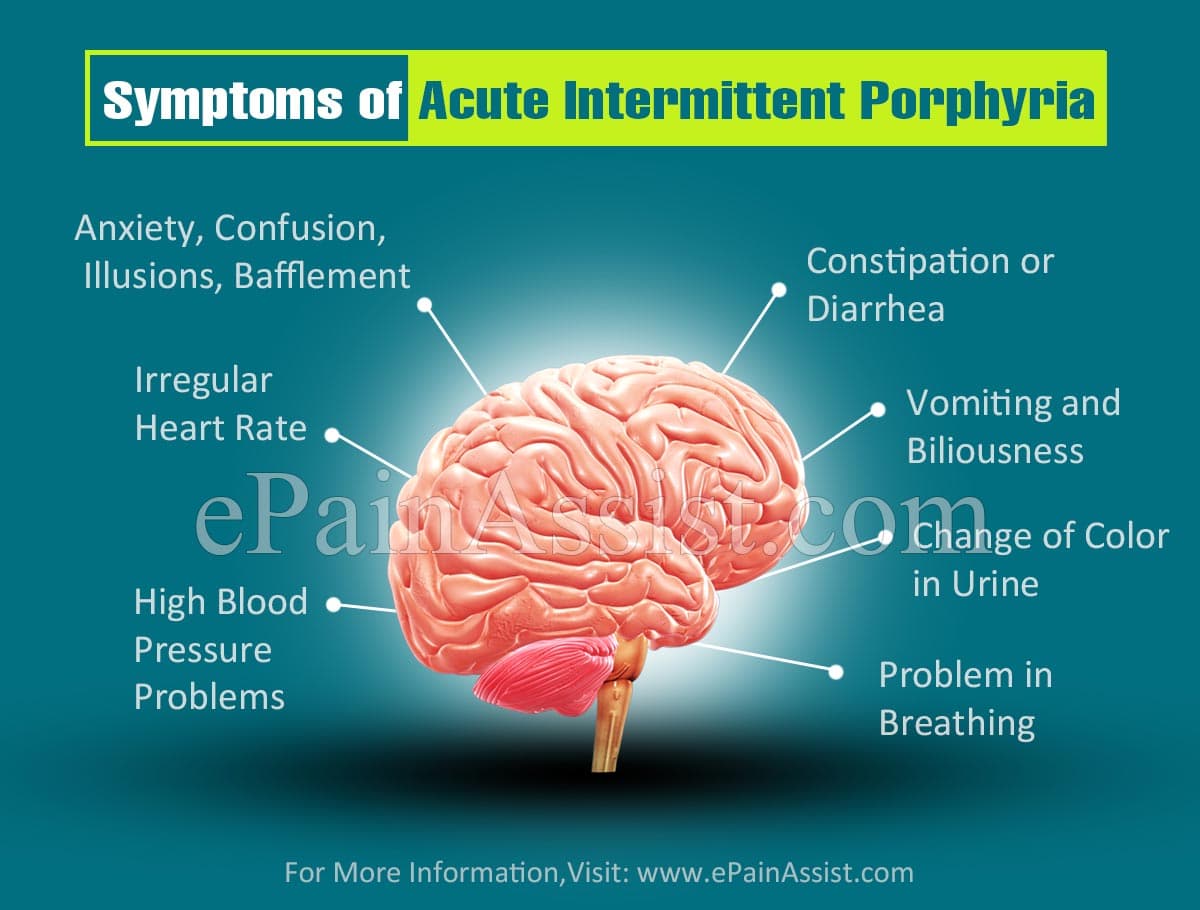What is Acute Intermittent Porphyria?
Acute intermittent porphyria is known as AIP. It is a very erratic autosomal dominant metabolic disorder which affects the production of heme, a iron-containing compound, due to the lack of porphobilinogen deaminase. Acute Intermittent Porphyria is caused by inheriting a defected gene from one or both of the parents. A latent Acute Intermittent Porphyria case is also noticed in patients[1].

Symptoms of Acute Intermittent Porphyria
The symptoms of acute intermittent porphyria vary from person to person and do not have any specific category. The symptoms can be severe and mainly affects the nervous system. Some symptoms of acute intermittent porphyria are discussed below:
An acute intermittent porphyria patient may suffer from abdominal pain which can be severe to acute.
Pain in various parts of the body can be felt like pain in legs, back pain, and even chest pain. Apart from these pains in the muscle, the person may feel weak and sometimes it may lead to paralysis.
- A person suffering from acute intermittent porphyria may suffer from constipation or diarrhea.
- Cases of vomiting and Biliousness are observed in patients.
- A change of color in urine is a noticeable symptom.
- A person may suffer from mental changes which can lead to anxiety, confusion, illusions, bafflement or paranoia.
- The problem in breathing is reported by the patients.
- Changes in heartbeat leading to irregular heart rate are felt by the acute intermittent porphyria patients.
- An acute intermittent porphyria patient can suffer from high blood pressure problems.
Causes and Diagnosis Acute Intermittent Porphyria
As already discussed, Acute Intermittent Porphyria includes a problematic heme production. Heme constitutes of protein present in hemoglobin that carries oxygen from lungs to all body parts. The production of heme takes place in bone marrow and liver with an involvement of 8 different types of enzymes. The lack of any one enzyme will be the cause of porphyria and its types. In acute intermittent porphyria, the damage is caused to nervous system. In most of the cases the porphyria is inherited. The inheritance can happen if a defective gene is inherited from any one of the parents or both of the parents. A person with the inherited gene will not always suffer from acute intermittent porphyria or will show sign or symptoms of it. There is a case called latent Acute Intermittent Porphyria in which the symptoms are seen in future generation[2]. Apart from the genetic risks, another factor involved is environmental factors which can also result in triggering of symptoms of acute intermittent porphyria.
When a person is exposed to this trigger, his or her body demands an increased production of heme. Triggering can include exposure to sunlight, can be caused by certain medication, sometimes fasting can also be a trigger factor, smoking, consumption of alcohol, emotional stress, all these factors contribute towards the onset of Acute Intermittent Porphyria. Apart from these, in women, certain hormones after menopause can also trigger acute intermittent porphyria.
The diagnosis of Acute Intermittent Porphyria is confirmed by urine test. If the symptoms of acute attacks are seen, then proper consultancy with doctor is mandatory.
Acute Attacks of Acute Intermittent Porphyria
Acute intermittent porphyria is one type of porphyria out of the four types of porphyria which involves acute attacks in patients. There are acute intermittent porphyria patients who suffer from repeated attacks; these attacks are very common in adults, especially women whereas it is barely noticeable in the age of puberty. In women, these attacks are not noticed after menopause. Attacks can vary from mild to a severe attack, in some cases a acute intermittent porphyria patient may need to hospitalization. Attack time can vary from a few hours to days. Symptoms of the acute intermittent porphyria can be reduced by some treatments like if the acute intermittent porphyria is caused by some kind of drug then it can be avoided or symptoms such as seizures are often very serious and will require medications to control it.
Conclusion
Acute intermittent porphyria is caused mainly by inheriting the defected genes from one of the parents. There is no prevention of acute intermittent porphyria but if the disorder is diagnosed, the factors responsible to trigger acute intermittent porphyria should be avoided in order to prevent symptoms of it. A person suffering from acute intermittent porphyria may notice various symptoms such as vomiting, mental confusion, and illusions, pain in several body parts and vomiting. Apart from these symptoms, a change in urine color is also noticeable. The treatment of these involves avoiding the triggering factors that causes the symptoms in order to reduce the side effects.
- https://www.ncbi.nlm.nih.gov/pmc/articles/PMC2932991/
- Dhital, R., Basnet, S., Poudel, D., & Bhusal, K. Acute intermittent porphyria: a test of clinical acumen. Journal Of Community Hospital Internal Medicine Perspectives, (2017). 100-102. doi: 10.1080/20009666.2017.1317535
